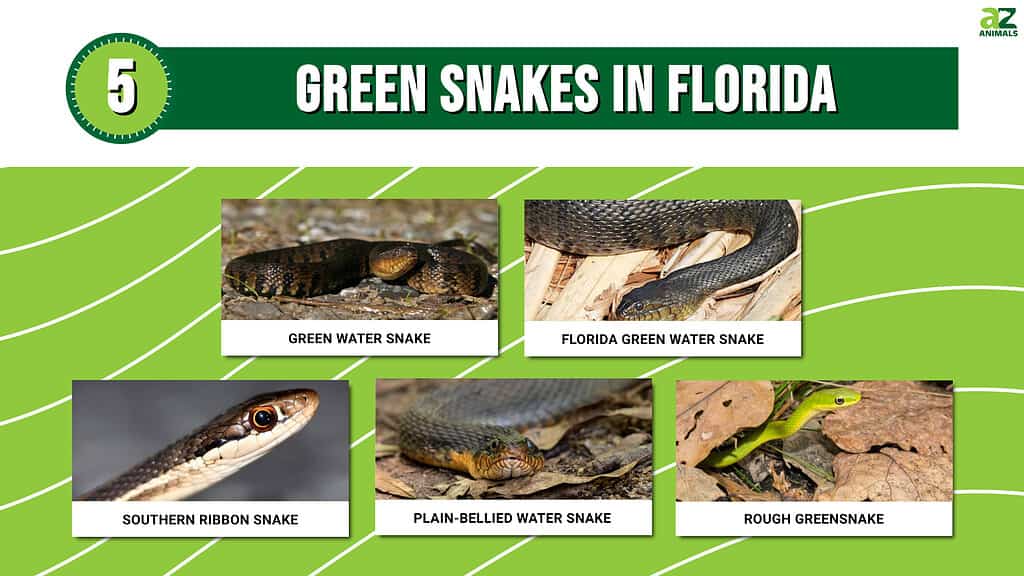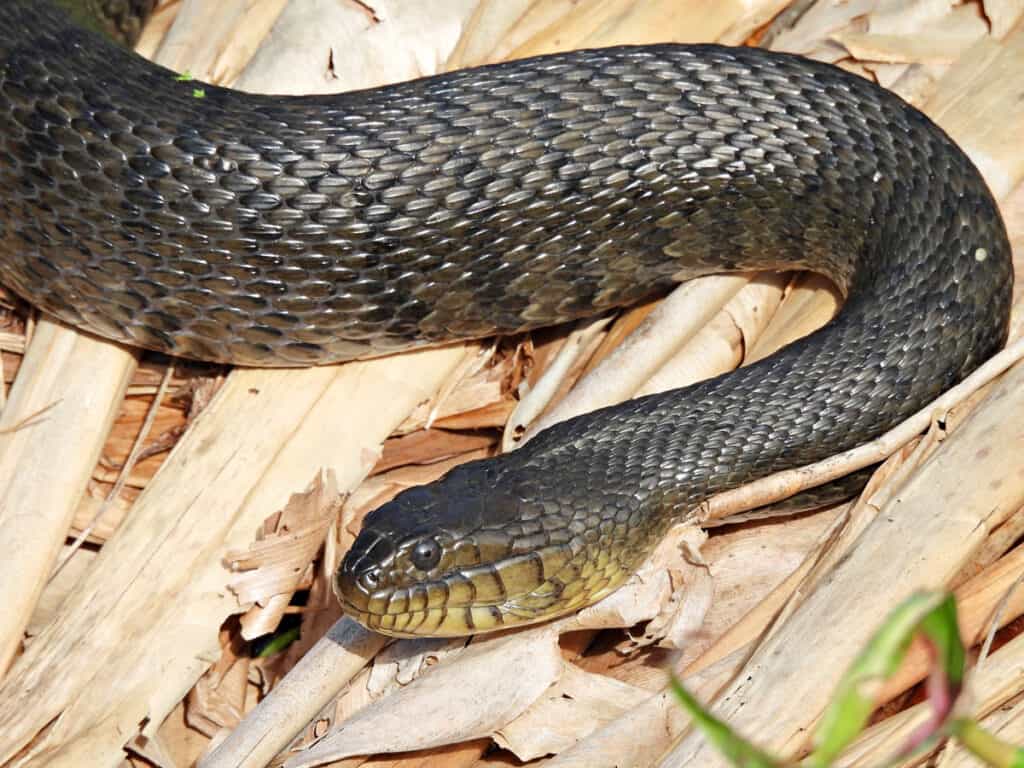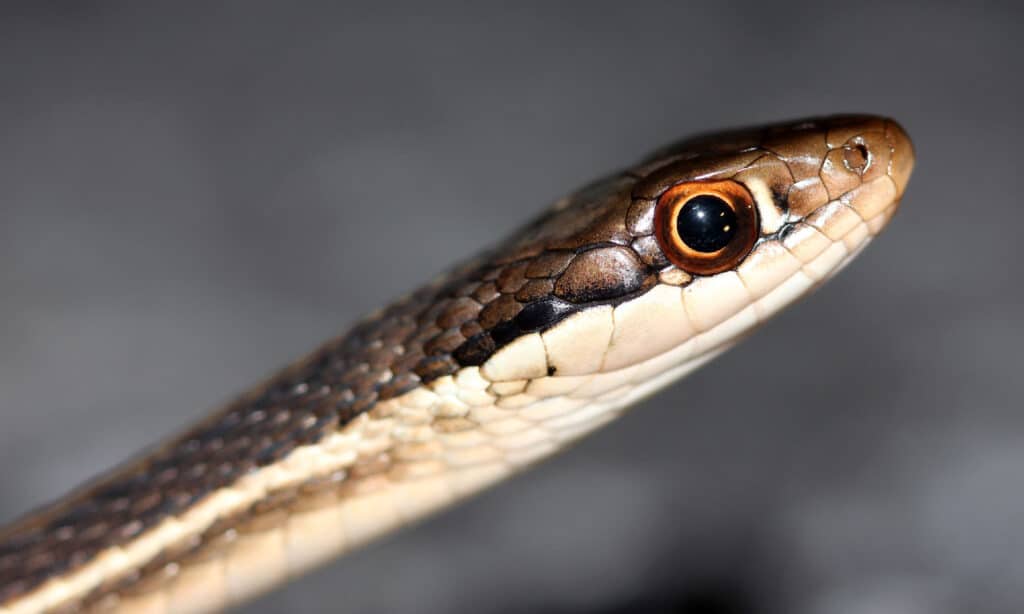Florida is without a doubt one of the most beautiful states in the US and is popular for its mild climate. Although much of Florida is subtropical, it is actually extremely diverse and has many rich ecosystems teeming with life. Many animals call Florida home – from the extremely rare to the most abundant.
Some of the most common animals in Florida are snakes. There are more than 50 native species, and they come in all sizes and colors. Some of these snakes use their color as camouflage to keep them hidden from predators, and one such color is green. So join us as we discover some of the green snakes in Florida! First we’ll give you a preview look, then read on for more detail:

Green Water Snake

©Ryan M. Bolton/Shutterstock.com
One of several water snakes in Florida is the green water snake (Nerodia cyclopion), also known as the Mississippi green water snake. Green water snakes are 30 to 55 inches long and are dark green or olive green. Several small scales underneath their eyes set them apart from other North American water snakes – with the exception of only the Florida green water snake which shares that trait. Green water snakes live in slow-moving water – such as lakes, ponds, streams, and swamps. They are occasionally found in brackish water.
Green water snakes are ovoviviparous and give birth to live young which are around 10 inches long. Depending on the size of the female, anything from 10 to 100 juvenile snakes can be born (typically in July or August). Green water snakes mainly eat fish, crayfish, and frogs. They are not venomous snakes but do sometimes strike when they are threatened. Predators of green water snakes include large birds and other snakes.
Florida Green Water Snake

.
©iStock.com/passion4nature
Another green snake in Florida is the Florida green water snake (Nerodia floridana). Florida green water snakes were originally classified as a subspecies of green water snakes before they were reclassified as their own species. They are the longest water snakes in North America and usually reach between 30 and 55 inches long, although a record of 74 inches has been observed. Florida green water snakes are typically greenish-brown with dark speckles. Their bellies are white or yellow but become darker underneath their tail. Just like green water snakes, they have one to three small scales underneath their eyes.
Florida green water snakes prefer calm water in ponds, lakes, swamps, and ditches where there is plenty of vegetation. In southern Florida, they remain active all year round, while in northern regions where it is colder they hibernate during the winter. Their diet mainly consists of fish, frogs, tadpoles, and salamanders. They are not constrictors, nor are they venomous, so prey is grabbed and swallowed alive. Predators of Florida green water snakes are otters, hawks, kingsnakes, and alligators.
Southern Ribbon Snake

©Ryan M. Bolton/Shutterstock.com
Also known as the Florida ribbon snake, the southern ribbon snake is the smallest subspecies of ribbon snake at 16 to 30 inches long. Southern ribbon snakes are typically olive green, although some older snakes are almost black. They have a light green dorsal stripe which is bordered by black and yellow stripes on their sides. Like all ribbon snakes, they have slender bodies which are where they get their name from. Another subspecies – the eastern ribbon snake – also occur in Florida.
Southern ribbon snakes are semi-aquatic and live in and around swamps, ponds, streams, and lakes – although no higher than 500 feet above sea level. They are also semi-arboreal and spend part of their time in trees. Like all ribbon snakes, they only eat cold-blooded prey such as frogs, toads, tadpoles, fish, and salamanders. They are not venomous or aggressive and prefer to flee when disturbed.
Plain-Bellied Water Snake

Another water snake in Florida is the plain-bellied water snake. Plain-bellied water snakes have thick bodies and are 24 to 40 inches long. They are usually olive green, greenish-brown, reddish-brown, or gray on their upper sides. However, their bellies are always a plain, solid color (typically orange to yellow) which is where they get their name from. Their color tends to vary depending on location and subspecies – for example, snakes in the western Panhandle region are greenish-gray dorsally.
Plain-bellied water snakes always live near permanent water sources – such as rivers, lakes, swamps, and floodplains. Despite being water snakes, they spend a lot of their time out of the water – basking on logs being a favorite pastime. They are most active during the summer months and are active during both the day and night in the middle of summer. However, they spend the winter hibernating in burrows or underneath rocks. Plain-bellied water snakes eat frogs, fish, and salamanders. Predators include hawks, egrets, kingsnakes, cottonmouths, and largemouth bass.
Rough Greensnake

©iStock.com/BobMcLeanLLC
The final green snake in Florida is the rough greensnake which is usually 14 to 33 inches long, although a maximum of 43 inches has been recorded. Rough greensnakes have slender bodies and long, thin tails. They are bright green on their dorsal side and have cream to yellow bellies. The scales on their bodies are keeled which means that they have raised ridges that give them a rough texture. Rough greensnakes prefer to live in meadows and woodlands, although they are never far from water and are good swimmers. They are also arboreal snakes and spend much of their time in trees. Their bright green color provides them with excellent camouflage and often makes them difficult to spot.
Rough greensnakes are diurnal rather than nocturnal like many other snakes. They are not venomous and are not aggressive snakes. When threatened they usually freeze and if they are in a tree then they tend to mimic a branch swaying in the wind. Rough greensnakes eat mainly insects and spiders, although some small frogs are also consumed. Predators include other snakes – such as eastern king snakes and eastern racers – and birds.
Summary of 5 Green Snakes in Florida
| Name of Snake | Length in Inches | Habitat |
|---|---|---|
| Green Water | 30-55 | Lakes, ponds, streams, swamps |
| Florida Green Water | 30-55 | Lakes, ponds, swamps, ditches |
| Southern Ribbon | 16-30 | Semi-arboreal; Lakes, ponds, streams, swamps |
| Plain-Bellied Water | 24-40 | River, lakes, swamps |
| Rough Greensnake | 14-33 | Arboreal: woodlands and meadows near water |
The photo featured at the top of this post is © iStock.com/BobMcLeanLLC
Discover the "Monster" Snake 5X Bigger than an Anaconda
Every day A-Z Animals sends out some of the most incredible facts in the world from our free newsletter. Want to discover the 10 most beautiful snakes in the world, a "snake island" where you're never more than 3 feet from danger, or a "monster" snake 5X larger than an anaconda? Then sign up right now and you'll start receiving our daily newsletter absolutely free.
Thank you for reading! Have some feedback for us? Contact the AZ Animals editorial team.






